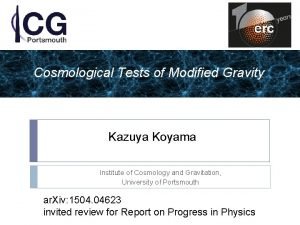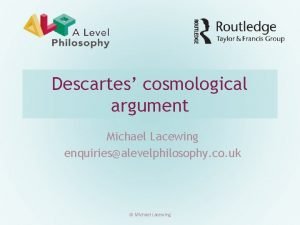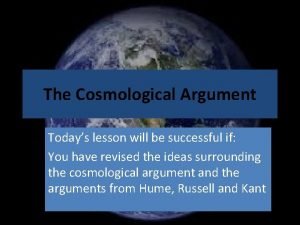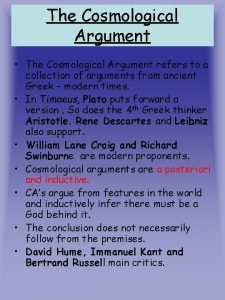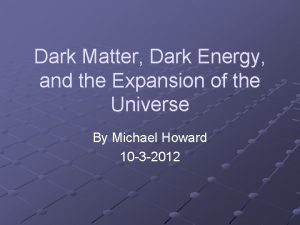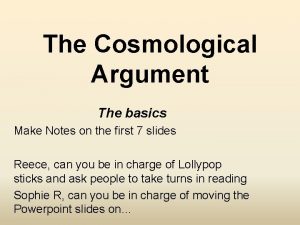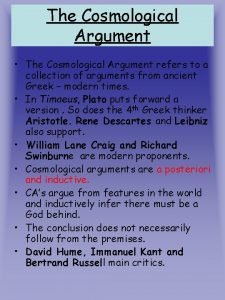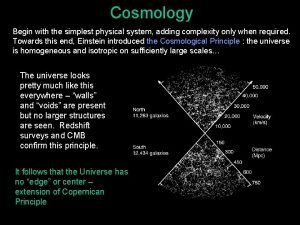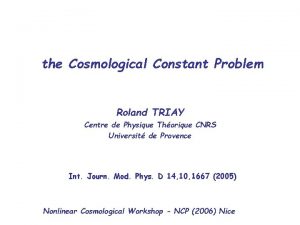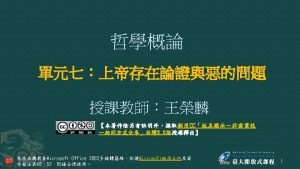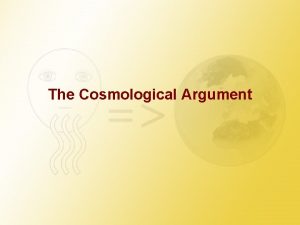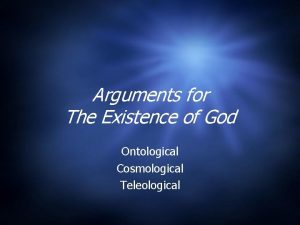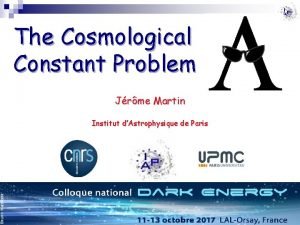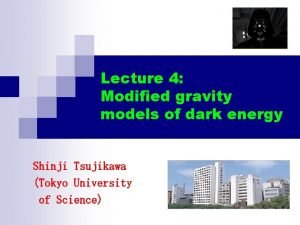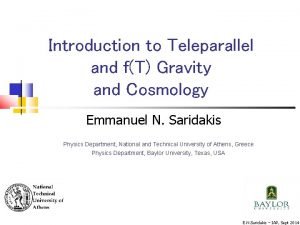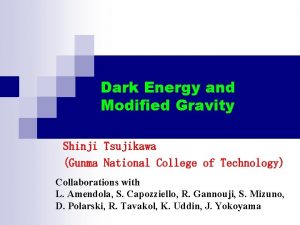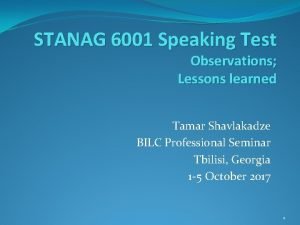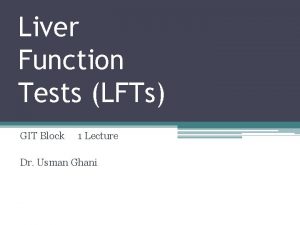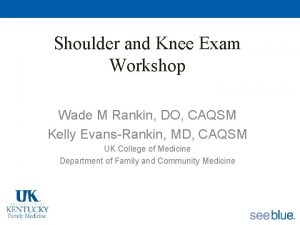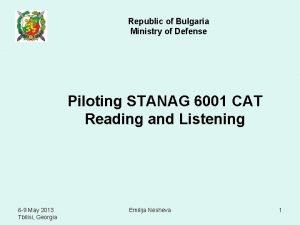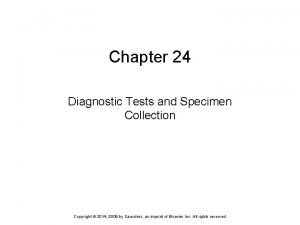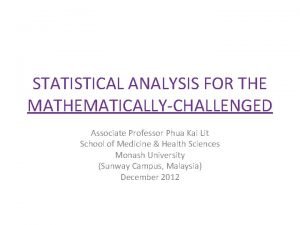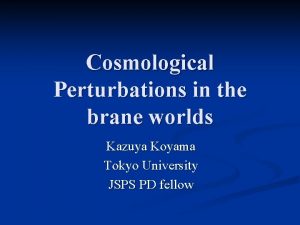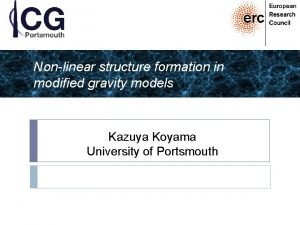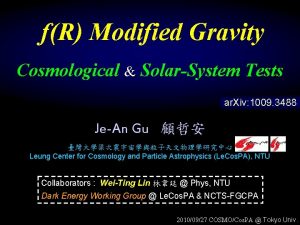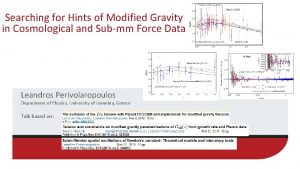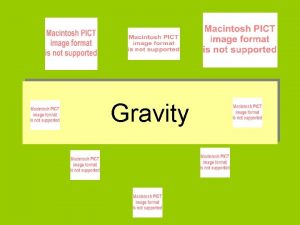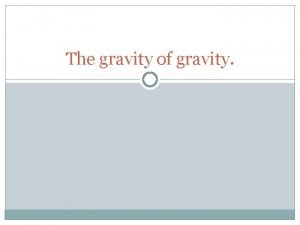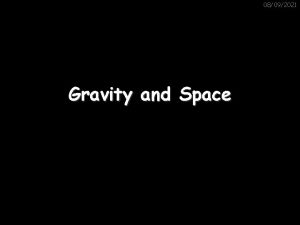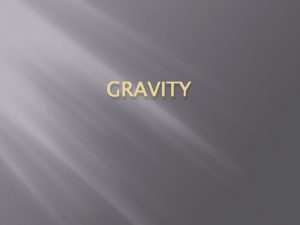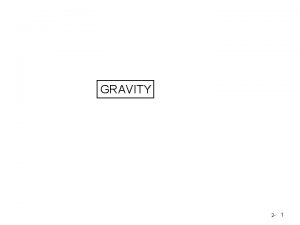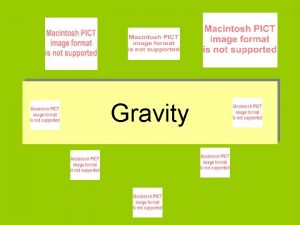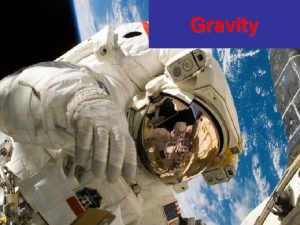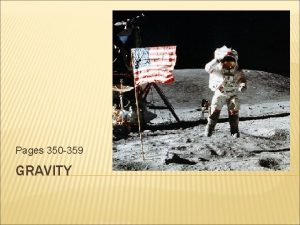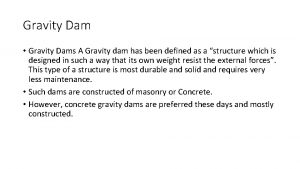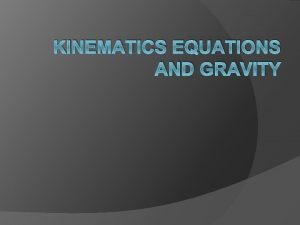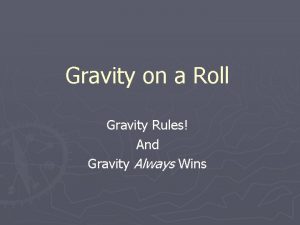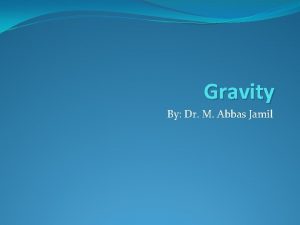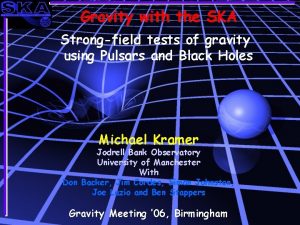Cosmological Tests of Modified Gravity Kazuya Koyama Institute





























- Slides: 29

Cosmological Tests of Modified Gravity Kazuya Koyama Institute of Cosmology and Gravitation, University of Portsmouth ar. Xiv: 1504. 04623 invited review for Report on Progress in Physics

Cosmic acceleration � Many independent data sets indicate the expansion of the Universe is accelerating � Standard cosmology requires 70% of unknown ‘dark’ energy

Psaltis Living Rev. Relativity 11 (2008), 9 Baker et. al. 1412. 3455 Assuming GR curvature Grav Probe B Hulse-Taylor 1 Rsun Moon Mercury Curvature 1 AU 10 kpc Dark Matter Dark Energy Gravitational potential 10 Mpc potential

Grav Probe B General Relativity Hulse-Taylor 1 Rsun Moon Curvature 1 AU Mercury Screening 10 kpc mechanism 10 Mpc Dark Matter Modified Gravity Gravitational potential Cosmological tests of gravity

Theoretical models � Recent interests in modified theories of gravity lead to new (and rediscovery of) interesting theories � Braneworld models � Massive/bi gravity � Horndeski theories The most general scalar tensor theory in 4 D with 2 nd order equations of motion (Horndeski ’ 74)

Theoretical models � Beyond Horndeski theories Talk by Vernizzi Higher time derivatives in general lead to instabilities (Ostrogradsky ghosts) Langlois, Noui 1510. 06930, 1512. 06820 If theory satisfies “degeneracy conditions”, Ostrogradsky ghosts Zumalacarregui, Garcia-Bellid 1308. 4685 can be avoided Gleyzes, Langlois, Piazza, Vernizzi 1404. 6459, 1408. 1952 Deffayet, Esposit-Farese, Steer 1506. 01974 Crisostomi, Hull, Koyama, Tasinato 1601. 04658 Example: Horndeski theory + generalised conformal and disformal Crisostomi, Koyama, Tasinato transformation 1602. 03119 Achour et. al. 1602. 08398, 1608. 08135 These theoretical models provide a theoretical motivation for what kind of deviations from GR one should search for

General picture � Largest scales Modified gravity is modified so that the universe accelerates without dark energy Scalar tensor � Large scale structure scales gravity is still modified by a fifth force from scalar graviton � Small scales (solar system) GR is recovered GR

Linear scales Talk by Silvestri, Pogosian � Linear scales “Model independent” parametrisations : Newtonian potential : Lensing potential assuming energy-momentum conservation of dark matter, these two equations are enough to describe linear cosmological perturbations Talk by Michele, Lewandowski, Trinh � Effective theory of dark energy PPF, Equation of State

Current constraints � Weak Lensing (WL)+ Red-Shift Distortion (RSD) WL RSD Song et. al. PRD 84 (2011) 083523 Planck 2015 “Modified gravity and dark energy” (Simpson et. al. MNRAS 429 (2013) 2249)

Going beyond linear scales � Ample information on non-linear scales Parametrisation is valid only for linear perturbations Conservative cut-offs are required to remove data on nonlinear scale, which significantly degrade the constraining power � Extraction of linear information For RSD, non-linear modelling is required to extract the linear growth rate, which is done normally within LCDM � New information on non-linear scales On non-linear scales, screening mechanisms can be important leaving interesting signatures

Why we need screening mechanism? � Brans-Dicke gravity quasi-static approximations (neglecting time derivatives) : fifth force

Constraints on BD parameter � Solutions � PPN parameter This constraint excludes any detectable modifications in cosmology

Screening mechanism Talk by Jimenez, Hagala, Zucca � Require screening mechanism to restore GR recovery of GR must be environmental dependent � make the scalar short-ranged using (chameleon) � make the kinetic term large to suppress coupling to matter using (dilaton/symmetron) or (k-mouflage) (Vainshtein) Break equivalence principle remove the fifth force from baryons (interacting DE models in Einstein frame)

Classification of screening mechanism � Classification Joyce et. al. 1407. 0059 These screening mechanisms can be classified whether the suppression of the fifth force is determined by � Potential (chameleon, dilaton/symmetron) � Gradient of potential (k-mouflage) � Curvature (Vainstein)

Behaviour of gravity There regimes of gravity Scalar tensor GR In most models, the scalar mode obeys non-linear equations describing the transition from the scalar tensor theory on large scales to GR on small scales Understandings of non-linear clustering require N-body simulations where the non-linear scalar equation needs to be solved

N-body Simulations for MG Talk by Baldi, Llinares � Multi-level adaptive mesh refinement � a scalar field solver using a non-linear Gauss Seidel relaxation ECOSMOG Li, Zhao, Teyssier, KK JCAP 1201 (2012) 051 MG-GADGET Puchwein, Baldi, Springel MNRAS (2013) 436 348 ISIS Llinares, Mota, Winther A&A (2014) 562 A 78 DGPM, Schmidt PRD 80, 043001 Modified Gravity Simulations comparison project Winther, Shcmidt, Barreira et. al. ar. Xiv: 1506. 06384

Example: f(R) gravity models Talk by Pace Winther et. al. 1506. 06384

Semi-analytic methods (see also Brax and Valageas 1205. 6583, 1305. � Perturbation theory approach On small scales, it is enough to go beyond linear order for the Newtonian potential Koyama et. al. 0902. 0618 Taruya et. al. 1309. 6783, 1408. 4232 Bose and Koyama 1606. 02520 Solve continuity and Euler equation numerically

An example: MG-Copter � Comparison with N-body Bose and Koyama 1606. 02520 based on Copter by M. White Taruya et. al. 1309. 6783, 1408. 4232 Bose and Koyama 1606. 02520

Red-Shift Distortion � RSD In redshift space, the clusteing is anisotropic due to peculiar velocities �Non-linear modelling ex). TNS mode Taruya, Nishimichi and Saito 1006. 0699 Perturbation theory growth rate

Examples: f(R), n. DGP Taruya et. al. 1309. 6783, 1408. 4232 Bose, Koyama et. al. 1702. 02348 f(R): scale dependent linear growth + chameleon screening n. DGP: scale independent linear growth + Vainshtein screening

Parameter estimation � Taruya et. al. 1309. 6783, 1408. 4232 Bose, Koyama et. al. 1702. 02348

Semi-analytic methods � COLA Tassev, Zaldarriaga, Eisenstein 1301. 0322 � 2 nd order Langangain Perturbation Theory (LPT) � Simulations (Particle-Mesh) Approximation for screening based on spherically symmetric solutions Winther and Ferreira 1403. 6492 Valogiannis and Bean 1612. 06469, Winther, Koyama et. al. 1703. 00879

Example: MG-PICOLA Winther, Koyama et. al. 1703. 00879 based on L-PICOLA Howlett et. al. 1506. 0373

Going beyond Liner scales � Tools have been developed � Extensions of “model independent” approaches MG-Copter: perturbative approaches (SPT, 2 LPT, …. ) Bose and Koyama 1606. 02520 MG-PICOLA: approximated methods (COLA, …) Winther, Koyama et. al. 1703. 00879 � Full N-body simulations (in a given model) We need to exploit information on non-linear scales to maximise the return from future surveys

Where to test GR � GR is recovered in “high dense regions” Scala Details depend on the screening mechanism r tenso GR r Chameleon mechanism � Screening of dark matter halos depends on mass and environment � Strongest constraints come from objects with a shallow potential in low density environment Vainshtein mechanism � Screening of dark matter halos does not depend on mass and environment � Strongest constraints come from linear scales

Testing chameleon screening � Outskirt of clusters Terukina. et. al. PRD 86 103503, JCAP 1404 013 less massiv e halos Dynamical mass can be inferred from X-ray and SZ 48 X-ray clusters from XCS compared with lensing (shear) from CFHTLS Wilcox et. al. 1504. 03937

Testing Vainshtein screening � Voids provide Falck, Koyama, Zhao and Cautun 1704. **** Falck et. al. 1404. 2206, 1503. 06673 Voids are emptier due to enhanced gravity (Void lensing) Velocities are enhanced as voids are unscreened (Void RSD)

Summary � In the next decade, we may be able to detect the failure of GR on cosmological scales � Linear scales Model independent tests of gravity � Non-linear scales SUMIRE EUCLID Tools to predict non-linear clustering have been developed in a general framework � It is possible to develop novel tests depending on Talk by Llinares screening mechanisms �
 Kazuya koyama
Kazuya koyama ıniqlo
ıniqlo Gravity for dummies and dummies for gravity equations
Gravity for dummies and dummies for gravity equations Descartes cosmological argument
Descartes cosmological argument Kant's criticism of cosmological argument
Kant's criticism of cosmological argument St thomas aquinas cosmological argument
St thomas aquinas cosmological argument Einstein cosmological constant
Einstein cosmological constant Cosmological argument poster
Cosmological argument poster St thomas aquinas cosmological argument
St thomas aquinas cosmological argument The universe expanding than
The universe expanding than Cosmological constant
Cosmological constant Argument from contingency
Argument from contingency St thomas aquinas cosmological argument
St thomas aquinas cosmological argument Ontological cosmological teleological
Ontological cosmological teleological Cosmological constant
Cosmological constant Modified gravity
Modified gravity Modified gravity
Modified gravity Tsujikawa
Tsujikawa Stanag speaking
Stanag speaking Lft normal range
Lft normal range Projective techniques in psychology
Projective techniques in psychology Empty-can test
Empty-can test Situational judgement test
Situational judgement test Romeo and juliet quote test
Romeo and juliet quote test Bulgaria
Bulgaria Romberga tests
Romberga tests Chapter 23 specimen collection and diagnostic testing
Chapter 23 specimen collection and diagnostic testing Psychology statistical test table
Psychology statistical test table Unlike psychological tests, behavioral assessments record
Unlike psychological tests, behavioral assessments record Ethylene oxide pcr tests
Ethylene oxide pcr tests
